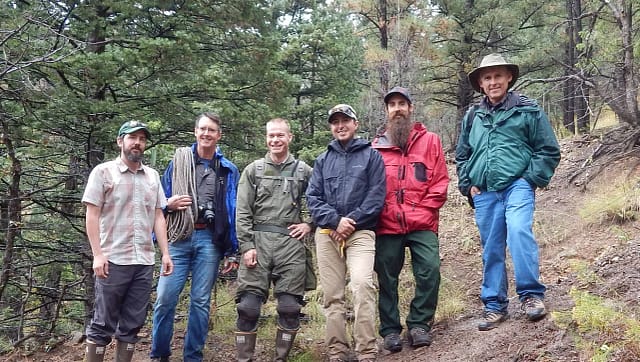Mines In Lincoln County Studied as Bat Habitats

Members of Bat Conservation International were in the area recently conducting a survey to be used in determining how several abandoned mines on the Lincoln National Forest should be treated. The forest is home to 16 kinds of bats, some of them regional-sensitive, and their presence in mine shafts is one factor in determining how and if an identified hazard should be closed.
A team of experts including Andrew Walker, Executive Director of Bat Conservation International (BCI), Jason Corbett, BCI Subterranean Program Director and Shawn Thomas, BCI Subterranean Program Manager, Mark Schwab, Abandoned Mine Lands Program Lead for the U.S. Forest Service and Larry Cordova, wildlife biologist, Nano Lucero, wildlife technician and Eric Turbeville, Recreation/Lands Assistant with the Smokey Bear Ranger District spent several days studying 27 potentially dangerous sites including several in Kraut and Tanbark Canyons near Bonito Lake, a cluster of five shafts in Krause Canyon off the Ski Area Road, a site near Blue Lake, east of Ruidoso, the Jicarilla Mining District and the Warnock mine near High Rolls.
To detect bats, Corbett and Thomas rappelled into the shafts looking for signs such as insect wings and guano.
“Even though bats typically congregate near the entrances, it’s impossible to look down from the surface to see evidence that they are there or how many might be using the shaft to roost,” Corbett said. “We really do need to go down and see what is there.”
In the case of the shafts in Krause Canyon, Corbett and Thomas found nine Townsend’s big-eared bats and one canyon bat.
“Seven of the Townsend’s were in torpor, meaning that they were getting ready to hibernate,” Thomas said. “The canyon was wedged up into a hole.”
The smallest bat in North America, canyon bats are often found in crevasses. They often are the first to exit the shafts when looking for food, taking advantage of less competition from larger bats.
Corbett explained that shafts make ideal roosting areas for bats.
“They like the air flow,” Corbett explained. “Given their surface area to volume ratio—the canyon bat’s body is the about the size of four Hershey kisses and they have a huge wing span—bats are prone to desiccation or drying out, especially in arid regions. Even though their bodies are small, water can still evaporate from their wings, so they like areas where it is cool and there is high humidity.”
When descending into shafts, there is always the danger of bad or contaminated air, so Thomas went down first with an air quality monitor that sends out an alert if low oxygen or gases such as carbon monoxide, methane, carbon dioxide, hydrogen sulfide or sulfur dioxide are present. Gases heavier than air can stratify and may settle along the floor of a mine and so the danger of these often toxic fumes can overwhelm an explorer quickly and at any time.
Fumes from guano can also be dangerous.
Walker told of an instance in exploring a cave in the Texas hill country where Mexican free-tailed bats were common. The distinctive sweet smell of their guano masks the presence of ammonia which is also hazardous and potentially deadly.
Other perils include rotting timbers, cave-ins, decaying explosives, deceased or hiding wildlife and, in the case of the cave in Texas, flesh eating beetles.
“The team had to use Hazmat suits and respirators to go into that cave,” Walker said. “While exploring they saw the perfect outline of a porcupine that went in, was overcome with the fumes and attacked by the beetles. All that was left were the quills.”
Corbett and Thomas found that the five shafts in Krause Canyon were interconnected and, instead of serving as air shafts for the nearby Silver Plume mine as commonly believed by locals, the holes followed a separate vein deep into the ground and were used to excavate and then transport the material out.
Supports were in place and, given that they were made of dimensional lumber, Corbett estimated that the shafts were dug in the 1940s.
A more thorough study will be done next as the forest archeologist will analyze the area as part of a cultural study. A public comment period follows with the final decision on what to do with the shafts up to the District Ranger, probably to be made mid-2016.
“We are always considering what is beneficial to the taxpayer in our recommendations,” Schwab said, “But, ultimately, it is up to the Ranger.”
Among the options are back filling or pumping foam to close a dangerous shaft and gates of closely welded bars or cupolas for the shafts where bats are discovered.
“Cupolas are good because they allow bats to circle as they leave the shaft and fly out openings in the sides,” Schwab explained. “The challenge is that the ground around the shaft needs to be level. In the case of the Krause Canyon site, the largest shaft was dug into a slight hillside, so we might have to go in and create a ledge for the cupola to sit on. A gate anchored into the hillside is another option.”
Any metal fabrication would be done on-site by approved contractors, using welders and generators brought to the area, specifically for that job, and then removed.
“We have to be careful at that stage as well, since bats are sensitive to disturbance,” Schwab said. “If they get upset, they will leave.”
“We walk a fine line between public safety and protecting bat habitats,” Walker said. “It may not seem like nine Townsend’s and one canyon bat is a large number, but it is significant, especially given the sensitivity of the Townsend’s. Our goal is to work with public agencies like the Forest Service and private land owners to identify what bats are present and to assess the quality of the habitat and to come up with the best option not only for the bats, but for the public as well.”